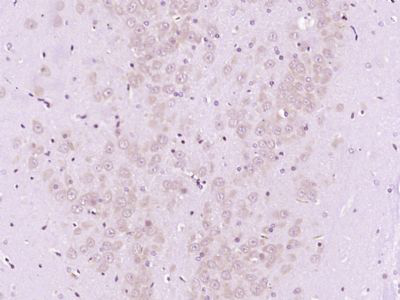产品货号 : mlR12380
英文名称 : WISP3
中文名称 : Wnt1信号通路蛋白3抗体
别 名 : CCN 6; CCN family member 6; CCN6; CYR61; LIBC; Lost in inflammatory breast cancer tumor suppressor protein; MGC125987; MGC125988; MGC125989; OTTHUMP00000040421; PPAC; PPD; UNQ462/PRO790/PRO956; WISP 3; WISP-3; WISP3; WISP3_HUMAN; WNT 1 inducible signaling pathway protein 3; Wnt 1 signaling pathway protein 3; WNT1 inducible signaling pathway protein 3; WNT1 inducible signaling pathway protein 3 precursor; WNT1-inducible-signaling pathway protein 3.
研究领域 : 肿瘤 细胞生物 发育生物学 信号转导 干细胞
抗体来源 : Rabbit
克隆类型 : Polyclonal
交叉反应 : Human, Mouse, Rat, Dog, Horse, Rabbit, Sheep, Monkey,
产品应用 : WB=1:500-2000 ELISA=1:500-1000 IHC-P=1:400-800 IHC-F=1:400-800 ICC=1:100-500 IF=1:100-500 (石蜡切片需做抗原修复)
not yet tested in other applications.
optimal dilutions/concentrations should be determined by the end user.
分 子 量 : 37kDa
细胞定位 : 分泌型蛋白
性 状 : Lyophilized or Liquid
浓 度 : 1mg/ml
免 疫 原 : KLH conjugated synthetic peptide derived from human WISP3:221-320/354
亚 型 : IgG
纯化方法 : affinity purified by Protein A
储 存 液 : 0.01M TBS(pH7.4) with 1% BSA, 0.03% Proclin300 and 50% Glycerol.
保存条件 : Store at -20 °C for one year. Avoid repeated freeze/thaw cycles. The lyophilized antibody is stable at room temperature for at least one month and for greater than a year when kept at -20°C. When reconstituted in sterile pH 7.4 0.01M PBS or diluent of antibody the antibody is stable for at least two weeks at 2-4 °C.
PubMed : PubMed
产品介绍 : Wnt-induced secreted protein (WISP)-1, WISP-2 and WISP-3 are members of the CCN family of growth factors, which include connective tissue growth factor (CTGF) and Cyr61. WISP-1, WISP-2 and WISP-3 share significant sequence similarity, including four conserved cysteine-rich domains, and they are believed to function as dimers in their active forms. WISP-1 expression is observed in various tissues including adult heart, kidney and spleen, while WISP-2 expression predominates in skeletal muscle, colon and ovary. Both WISP-1 and WISP-2 are upregulated in cells transformed with the proto-oncogene Wnt-1, and they are also more highly expressed in human colon tumors, suggesting that these proteins may participate in tumor development. WISP-3 is involved in normal post-natal skeletal growth, and it is also implicated in the development of the autosomal recessive skeletal disorder progressive pseudorheumatoid dysplasia, which affects cartilage homeostasis by disrupting the growth of chondrocyte and normal cell columnar organization.
Function:
Appears to be required for normal postnatal skeletal growth and cartilage homeostasis.
Subcellular Location:
Secreted.
Tissue Specificity:
Predominant expression in adult kidney and testis and fetal kidney. Weaker expression found in placenta, ovary, prostate and small intestine. Also expressed in skeletally-derived cells such as synoviocytes and articular cartilage chondrocytes.
DISEASE:
Defects in WISP3 are the cause of progressive pseudorheumatoid arthropathy of childhood (PPAC) [MIM:208230]. PPAC is an autosomal recessive disorder characterized by stiffness and swelling of joints, motor weakness and joint contractures. Signs and symptoms of the disease develop typically between three and eight years of age. This progressive disease is a primary disorder of articular cartilage with continued cartilage loss and destructive bone changes with aging.
Similarity:
Belongs to the CCN family.
Contains 1 CTCK (C-terminal cystine knot-like) domain.
Contains 1 IGFBP N-terminal domain.
Contains 1 TSP type-1 domain.
SWISS:
O95389
Gene ID:
8838
Important Note:
This product as supplied is intended for research use only, not for use in human, therapeutic or diagnostic applications.
产品图片












